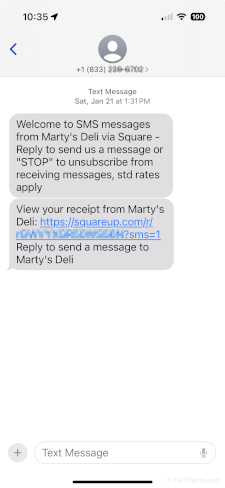SMS
Stands for "Short Message Service."
SMS is a communications technology that sends text messages to mobile phones. SMS messages are short, up to 160 characters long when using alphanumeric characters, or up to 70 characters if the message includes special symbols or accented letters. They are transmitted across mobile phone networks and addressed to phones using the same phone number as voice calls.
SMS technology was first created for phones on GSM mobile networks in the early 1990s. The convenience of sending a short text message instead of making a phone call helped it catch on quickly, even though mobile phones of the time lacked proper keyboards — users had to type their messages using a numerical keypad. SMS is a store-and-forward technology, so if a phone is offline or out of a network's range, the carrier holds on to incoming messages until the phone reconnects to the network.
In addition to mobile-to-mobile messaging, SMS allows computer systems connected to a mobile network to send automated messages. These services can use either a normal phone number or a unique short code — a 5- or 6-digit number assigned by a mobile carrier. They can send messages in response to an SMS prompt, an online request, or without any prompt at all. For example, a two-factor authentication service can use SMS to send you a login code, while a mobile payment processor can use it to send you a transaction receipt. Other services may send you appointment reminders, marketing messages, or news updates.
While SMS is limited to sending short, text-only messages, other technologies based on it add more features. MMS (Multimedia Messaging Service) is an extension of SMS that lets you send images, video, and audio files. RCS (Rich Communication Services) adds even more features to SMS, including delivery and read receipts and a much higher character limit. However, other messaging services built on IP networks like WhatsApp and Apple's iMessage are now more popular than basic SMS. These allow you to send messages from a smartphone, tablet, or computer through any Internet connection instead of relying strictly on a mobile phone network.
 Test Your Knowledge
Test Your Knowledge